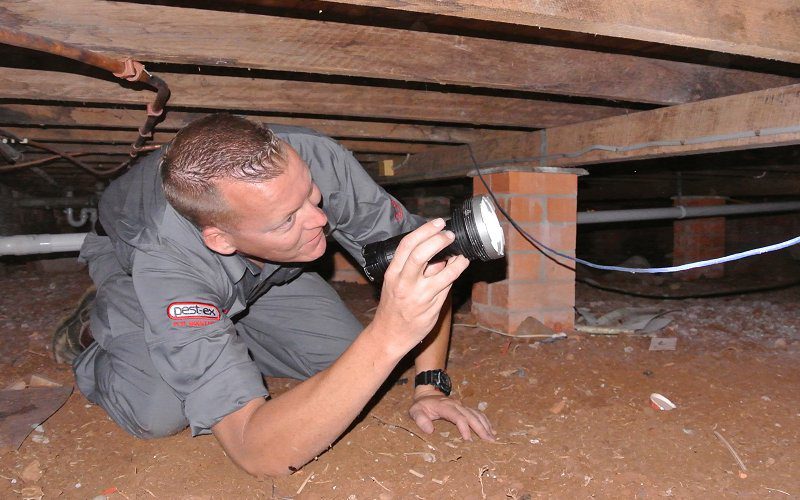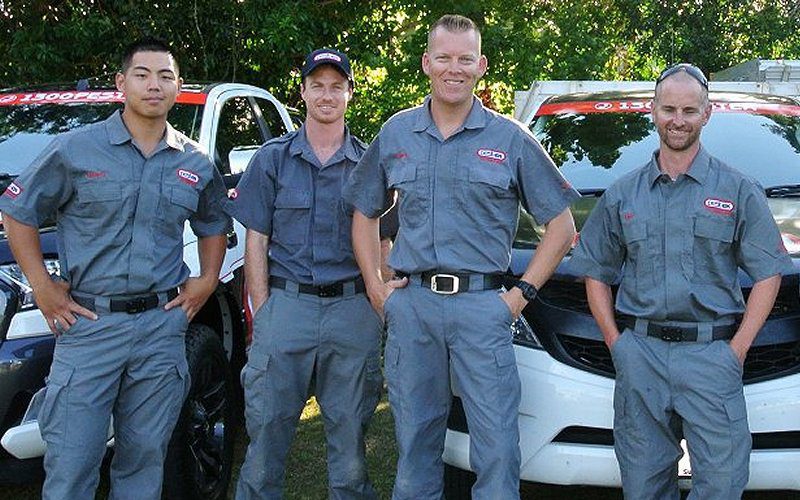
Got a Pest Problem? Call Us Today →
Termites are commonly known as a homeowner’s worst nightmare and have the ability to go undetected for long periods of time while silently attacking your house, one bite at a time from the inside out.
These highly destructive pests have an enormous appetite for cellulose-based materials, including the wood in your home, so unless you have a house built entirely out of concrete and steel, it’s at risk of being attacked by termites. There’s nothing worse than finding out that your family home which you’ve invested years of time, love and money into is being quietly and systemically destroyed by tiny soft-bodied reapers of destruction.
However, it’s not all doom and gloom – having a termite inspection by a fully qualified and licensed pest control technician, on a regular basis and by implementing a few precautions around the home, can effectively keep these destructive pests from destroying your much-loved home.
Where you live plays a big role in deciding how often you should have your house inspected for termites. Australia is considered a ‘hot spot’ for termites due to the hot and humid climate it experiences in most parts of the country – most a large chunk of the year. Australian standards highly recommend that most homeowners south of the Capricorn Tropic have a qualified pest control technician inspect their property for termites every 12 months.
The Tropic of Capricorn is the southern boundary of the tropics that pin points the southernmost latitude at which the sun can be seen directly from above at midday. For this reason, the whole of Australia is considered to be very high-risk for termites. Most places in Australia fall south of the tropic with the exception of places such as, Alice Springs and parts of Western Australia and Queensland such as, Rockhampton.
These areas are actually situated north of the Tropic of Capricorn and are considered to be at an even greater risk of a termite attack. If you own a home north of the tropic you should have your termite inspection carried out every six months rather than annually.
If you’ve not had an inspection before or have let your last one lapse longer than a year, give a professional a call today.

One of the best ways to defend your home against a termite attack is to have a perimeter barrier installed either at the time of construction, or after an attack which is designed to block concealed termite entry into homes. This barrier acts as insurance against a termite attack but is only valid if you maintain your recommended inspections by a qualified technician.
If your home has been infected with termites in the past and they’ve been completely eliminated, as long as you have a perimeter barrier in place, there is no need to have more frequent termite inspections. Your protection qualifies you as low-risk and you’re able to stick to the standard 12-month inspection period.
However, if you kill all the termites in your house without implementing a barrier of protection afterwards, there is nothing to stop a new termite colony from coming onto the property underground. Once they find an old termite colonies’ underground tunnel leading to your house, that new colony of termites will follow it straight back into your home looking for their food source.
When there has been a confirmed case of termites in one of your neighbour’s homes, it’s important have a qualified technician come out and inspect your property at the same time. Termite are able to travel 50 to 80 metres from their colonies so just because your neighbour’s home is under a termite attack, it doesn’t necessarily mean they have come from within that particular house.
Old untreated wood is a breeding ground for termites so it’s possible for those termites to have made their colony in an old tree stump in the backyard of the house to your left, and for them to travel underground and straight into the house on your right!
Therefore, it’s highly recommended that should your neighbours have termites that you enlist a technician to inspect your property at the same time. Just importantly, having a perimeter barrier installed is always your best protection against repeated termite attacks.

Warm conditions are ideal for termite colonies as they prefer an average temperature of 25-28 degrees. In parts of Australia where it’s warm most of the year, there’s only around three to six weeks of cooler weather temperatures that are less than the ideal for termite activity. However, once the weather warms up again and it hits the cocktail mix of humidity and moisture, termites are out in full force.
It’s important to note that regardless of the season, there’s no ‘ideal’ time of the year to get an inspection. Getting a pest control technician to inspect your home won’t stop you from getting termites, nor will having him inspect your house in summer or winter effect the outcome. Over a 12-month period it’s still highly possible for termites to do a lot of damage, but not enough to cause structural damage and have your house to fall down.
The key to reducing the level of damage is having an inspection of your property by a qualified technician once a year, every year. A termite inspector can identify termites in their early stage of destruction and prevent serious structural damage to your home.
Having regular termite inspections under the protect of a perimeter termite barrier is your best defence against termites destroying your home. Not every homeowner is able to implement a such protection however as many families are on fixed budget. Having to deal with the getting rid of their termite problem will sometimes take priority over paying for further prevention or protection.
If you find termites in your home such as in your living room wall, and for whatever reason you choose not to implement a perimeter termite barrier, a qualified professional will treat the targeted area, resulting in the killing of those termites in that wall. It’s vital to have your home inspected every six months after that pest control treatment, so if they do come back, a professional technician can reapply treatment and slow down further damage to your property.
It’s important to remember that without the barrier protection in place, any termite treatment is merely a short-term solution. Without installing a perimeter termite barrier to protect your property, the termites will always come back. It may take six months or it may take four years but eventually a new colony will track the pheromone trail of the last termites, and hitch a ride on that highway straight back into your home – where the destruction will begin all over again.
Termites absolutely thrive in water and moisture and it’s very common for homeowners to discover termite issues during periods when they’ve had plumbing problems such as, bathroom leaks or for homes built on steep blocks up against high moisture areas. Due to the long time frame it may take for the moisture to completely dry out, you may need a termite inspection every six months after the initially treatment, for up to two years. Once you’ve been given the all clear it’s safe to go back to annual inspections.

Choose Pest Ex for your pest control and termite treatment needs because:
If you’ve not had a termite inspection of your property within the past 12 months, give a professional pest control technician a call today.







